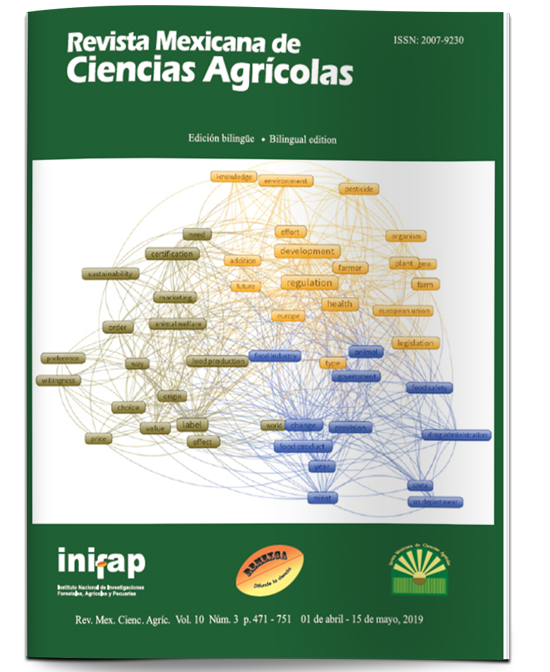Forage yield of maize adapted to the humid tropic of Mexico
DOI:
https://doi.org/10.29312/remexca.v10i3.1546Keywords:
Gramineae, forage production, hybrids, synthetic varietyAbstract
A study was carried out in Loma Bonita, Oaxaca with the objective of evaluating the forage yield of maize genotypes adapted to the humid tropics of Mexico. The preparation of the land consisted of a fallow, tracing, crossed and furrowed, the establishment of the genotypes was on October 6, 2012, having as treatments six maize genotypes: NH-5, HE-1A17, VS-536, H -564C, DK-357 and H-520 that were distributed in a randomized block experimental design with divided plots and three replications, where the effect of three planting densities for each genotype was evaluated at 50 000, 62 500 and 83 333 plants ha-1. To estimate the differences between genotypes and sowing densities, the information was subjected to an analysis of variance and Tukey’s mean comparison test (p£ 0.05). At the time of harvesting the forage in January 2013, the characters plant height (Alp), male and female flowering (Dfm, Dff), leaf area (Aft), stem diameter (Dta), total leaves and leaves above of corn (Nho, Hae), cobs per plant (Epp), knots per plant (Npp), weight of leaves and stems (Pho, Pet), weight of corn with and without bracts (Peho, Pesh), length and diameter of corn (Lel, Delo), rows per corn, grains per row and grains per corn (Nhel, Ngh, Nge), weight of cobs (Pes) and yield in fodder (ren) were studied.. The results indicated that on average of three planting densities the genotypes VS-536 (38.8 t ha-1) and H-564C (36.6 t ha-1) excelled in forage production. The sowing density of 83 333 plants ha-1, in average of genotypes, produced the highest forage yield of 41.8 t ha-1. Considering the interaction of genotype by density, there was a high production of green biomass with the variety VS-536 (49.5 t ha-1) established at 83 333 plants ha-1.
Downloads
Downloads
Published
How to Cite
Issue
Section
License
The authors who publish in Revista Mexicana de Ciencias Agrícolas accept the following conditions:
In accordance with copyright laws, Revista Mexicana de Ciencias Agrícolas recognizes and respects the authors’ moral right and ownership of property rights which will be transferred to the journal for dissemination in open access. Invariably, all the authors have to sign a letter of transfer of property rights and of originality of the article to Instituto Nacional de Investigaciones Forestales, Agrícolas y Pecuarias (INIFAP) [National Institute of Forestry, Agricultural and Livestock Research]. The author(s) must pay a fee for the reception of articles before proceeding to editorial review.
All the texts published by Revista Mexicana de Ciencias Agrícolas —with no exception— are distributed under a Creative Commons License Attribution-NonCommercial 4.0 International (CC BY-NC 4.0), which allows third parties to use the publication as long as the work’s authorship and its first publication in this journal are mentioned.
The author(s) can enter into independent and additional contractual agreements for the nonexclusive distribution of the version of the article published in Revista Mexicana de Ciencias Agrícolas (for example include it into an institutional repository or publish it in a book) as long as it is clearly and explicitly indicated that the work was published for the first time in Revista Mexicana de Ciencias Agrícolas.
For all the above, the authors shall send the Letter-transfer of Property Rights for the first publication duly filled in and signed by the author(s). This form must be sent as a PDF file to: revista_atm@yahoo.com.mx; cienciasagricola@inifap.gob.mx; remexca2017@gmail.
This work is licensed under a Creative Commons Attribution-Noncommercial 4.0 International license.



